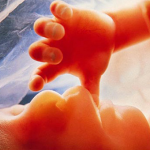Written by Andrew Murphy
A consistent theme which runs through the writings of G. K. Chesterton is the capacity to wonder at the world, particularly by rediscovering a sense of awe for ordinary and familiar things by looking at them from a new perspective.
In The Everlasting Man, he laments that we have become so familiar with matters of faith that we are no longer astonished by them, and may even begin to hold them in contempt. As an antidote, he encourages the reader to look at matters of faith as “entirely unfamiliar and almost unearthly”[1] in order to regain an appreciation for the truth we have lost sight of.
To demonstrate his point, he offers an example of what might be necessary for someone to recover a sense of wonder at the fact that men are able to ride horses. He attempts to describe a horse as the first man might have seen it, as some kind of prehistoric creature lumbering out of a forest on “solid clubs of horn” with a “strangely small head” spouting from its thick neck like that of a gargoyle. [2]The image he offers is monstrous, but it causes us to look at a horse with new eyes and realise what a strange creature it actually is, and how impressive it is that men are able to ride them.
We might attempt a similar thing with something as commonplace as the humble pineapple. Imagine encountering one for the first time while exploring a tropical island after being shipwrecked. You would see what looks like a yellow football covered in a skin of armour, with a green crown exploding from the top. In a sense it is a very ugly thing and we would probably steer clear of it if we encountered it for the first time in some foreign jungle. Yet pierce its outer shell and a soft and juicy flesh is unveiled, and a refreshing sweetness that is hidden by a rigid, highly protective exterior. Suddenly it seems almost adventurous and exciting that this strange plant is something we can eat, and not only eat but thoroughly enjoy.
While it is highly important not to lose sight of how amazing pineapples are, there are actually more serious things that we fail to appreciate through familiarity.
For me, one of these is the crucifix. It is the most iconic image associated with Christianity, and yet I find that I am exposed to it so frequently that it becomes merely a standard part of Church decoration, or something people wear on a necklace. While I obviously know the significance and meaning of it, more often than not I fail to think of this when I see one.
One time during Mass at Rouse Hill in Sydney, I was looking at the impressive crucifix above the altar, and was randomly struck by how it is such a strange symbol. It’s something I see every time I’m in a Catholic Church, or most Catholic homes, but I often fail to appreciate how shocking it actually is. I started to think about what it would be like to encounter one for the first time, with no knowledge of what it represented.
Imagine walking into the temple of some unknown religion, marvelling at the towering pillars, beautiful paintings, and intricate stained glass windows, only to look to the altar and see a massive sculpture of a dead man nailed to some wooden beams. Then, imagine turning in shock to ask one of the worshippers why there is such a terrifying image of death and execution staining their otherwise beautiful building, only to be told that it is the greatest sign of the love of the Universal Creator, and the image in which they place all their hope, and find the meaning for their lives.
Surely we would see the worshipper as a madman, and the temple as a house of horrors. Yet this is exactly what the cross is, an image of horrendous torture and death, proudly displayed in our churches as the greatest sign of love the world has ever seen. On the surface it is actually repulsive: a bloodied human body run through with nails, stretched out on two pieces of wood, with a tangle of thorns digging in to its lifeless head. It is probably one of the most striking images of human evil and cruelty – and yet paradoxically, it is because of this that it is truly an image of hope.
If the crucifix were simply a glorified image of a Roman crucifixion victim, then the churches in which it hangs would be madhouses for some sick and twisted cult of human sacrifice. But, of course, this is not the case. Deeper than the surface is the belief that this tortured body is actually the body of the Universal Creator, who descended from his Heavenly throne into the darkness of a world which had cut itself off from its source of life.
This image of death brings hope and life, because it reminds us that no matter how much we suffer, or stray into the darkness, the Light of the world has gone there before us and is waiting with open arms, saying that there is no place He will not go to bring us back. Most importantly, it is a reminder that the horror and suffering of the cross, and of this life, is only a brief moment in time before the Resurrection. It is only a short night of darkness before an eternal dawn.
Yet there is something even more profound than the crucifix to be encountered within the church. For in the tabernacle, and on the altar at every Mass, the One the crucifix symbolises is truly present under the appearance of the most humble of foods. As Fulton Sheen wrote in his brilliant book, The Life of Christ, “divinity is always where one least expects to find it.” What human mind would have imagined that the King of Heaven and Earth would have been born in a stable, that God would come to earth only to be nailed to a tree and killed by His own creatures, that the Creator of the Universe would allow Himself to be consumed like a piece of bread? But this is what Catholics believe – that the the Eucharist is truly the Body and Blood of Christ and that those who take and eat will have eternal life. However, just as I have often failed to appreciate the crucifix, it seems many fail to appreciate and comprehend the significance of the Eucharist. Instead, they see It as merely a symbol.
Bishop Athanasius Schneider of Kazakhstan has lamented the loss of reverence which can be observed in churches all over the world where many people receive the Eucharist in an overly casual manner. He suggests a return to the traditional practice of receiving Our Lord on the tongue while kneeling could help safeguard against a loss of wonder and awe for the Eucharistic mystery. He argues that this posture “manifests in an opportune and felicitous way the interior attitude of a child who allows himself to be fed.”[3] He also points out that “the Church prescribes that during the celebration of Holy Mass, at the Consecration, the faithful must kneel. Would it not be more liturgically proper if, at the moment of Holy Communion when the faithful approach the Lord on a bodily manner as closely as possible, the One Who is the King of Kings, that they would greet Him and receive Him on their knees?”[4]
This outward testimony could well be the re-presentation of the “source and summit” of our faith that many lukewarm Catholics need. It could be a physical sign which helps them to see the Eucharist with new eyes, as if for the first time, since kneeling and spiritual childhood are “completely foreign phenomena”[5] to our modern, Godless culture.
There is no doubt the modern world is drowning in a culture of death and confusion about what it even means to be human, but this should not really be surprising because when God is forgotten “the creature itself grows unintelligible.”[6] When there is no higher authority, when people believe there is nothing more than this world, all they have to lead them are their passions. We all desire happiness, but if we don’t have anyone pointing us to where it can be found we are doomed to get lost along the way.
I sometimes find myself wondering whether all the problems facing our world would be fixed in an instant if Christ was living on earth today. I was not surprised to discover Chesterton was also pondering this question during the first half of the 20th century and I will finish with this quote:
“If I am to answer the question, “How would Christ solve modern problems if He were on earth today?”, I must answer it plainly; and for those of my faith there is only one answer. Christ is on earth today; alive on a thousand altars; and He does solve people’s problems exactly as He did when He was on earth in the more ordinary sense. That is, He solves the problems of the limited number of people who choose of their own free will to listen to Him.”[7]
This is an updated and expanded version of an article titled ‘The Wonder of Chesterton’, which was published in the Winter 2019 edition of ‘The Defendant’, the quarterly newsletter of the Australian Chesterton Society.








